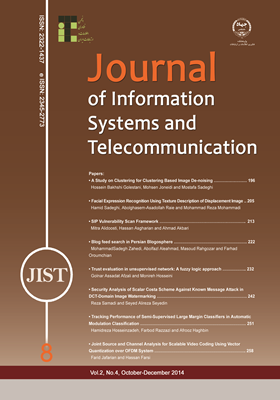-
-
List of Articles
-
Open Access Article
1 - A Study on Clustering for Clustering Based Image De-noising
Hossein Bakhshi Golestani Mohsen Joneidi Mostafa Sadeghi -
Open Access Article
2 - Facial Expression Recognition Using Texture Description of Displacement Image
Hamid Sadeghi Abolghasem Asadollah Raie Mohammad Reza Mohammadi -
Open Access Article
3 - SIP Vulnerability Scan Framework
Mitra Alidoosti Hassan Asgharian Ahmad akbari -
Open Access Article
4 - Blog feed search in Persian Blogosphere
Mohammad Sadegh Zahedi Abolfazl Aleahmad rahgozar rahgozar Farhad Oroumchian -
Open Access Article
5 - Trust evaluation in unsupervised network: A fuzzy logic approach
Golnar Assadat Afzali Monireh Hosseini -
Open Access Article
6 - Security Analysis of Scalar Costa Scheme Against Known Message Attack in DCT-Domain Image Watermarking
Reza Samadi Seyed Alireza Seyedin -
Open Access Article
7 - Tracking Performance of Semi-Supervised Large Margin Classifiers in Automatic Modulation Classification
Hamidreza Hosseinzadeh Farbod Razzazi Afrooz Haghbin -
Open Access Article
8 - Joint Source and Channel Analysis for Scalable Video Coding Using Vector Quantization over OFDM System
Farid Jafarian Hassan Farsi
-
The rights to this website are owned by the Raimag Press Management System.
Copyright © 2017-2025







